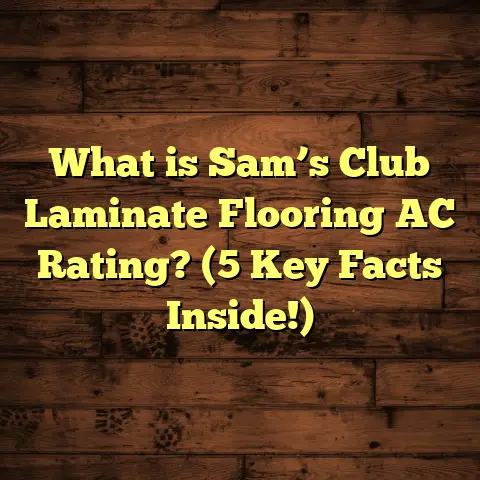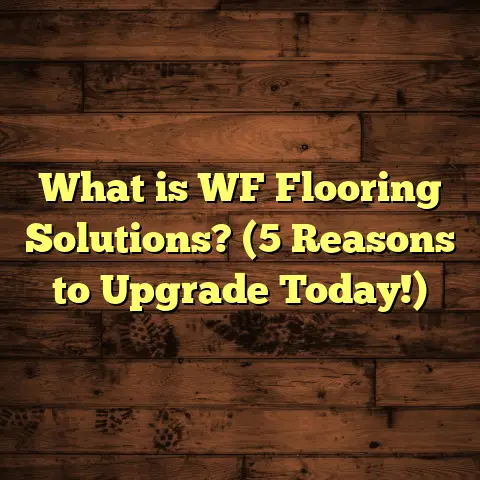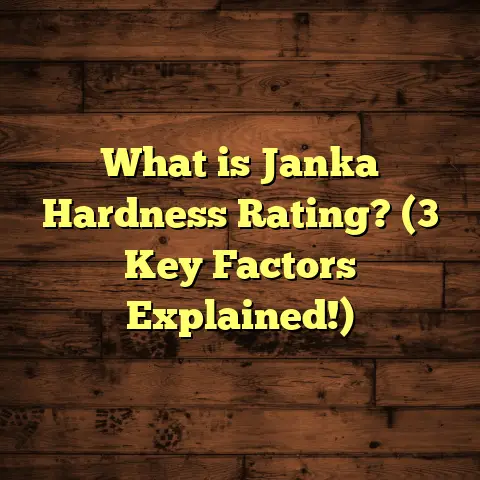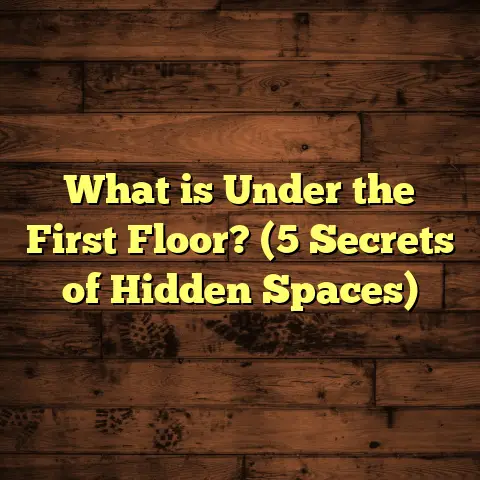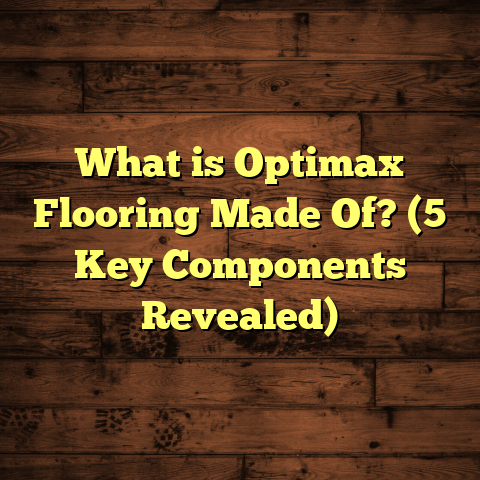What is a Vinyl Plank Floor? (5 Benefits You Must Know!)
Did you know that in 2023, nearly 39% of all new residential flooring installations in North America were luxury vinyl plank (LVP)? That’s almost double the share from just five years ago! I remember reading that statistic in a trade magazine while waiting for my coffee to brew and thinking, “Wow, I’m definitely not the only one obsessed with this stuff.” So why is everyone talking about vinyl plank flooring? Why are more and more homeowners—myself included—choosing it over traditional hardwood, tile, or even carpet?
Let me walk you through my journey with vinyl plank flooring: how it works, why it’s taken over so many homes (including my own), and the major benefits that still surprise me after countless installations.
What Is Vinyl Plank Flooring?
Vinyl plank flooring is a synthetic flooring material designed to look like natural wood planks. It consists of several layers: a backing layer for stability, a core layer (sometimes waterproof), a high-definition photographic layer that mimics real wood grain patterns, and a tough wear layer that resists scratches and stains. There’s even a UV coating on some products to prevent fading.
When I first started working as a flooring contractor, vinyl flooring meant those thin, shiny sheets people glued onto their kitchen floors in the ‘80s and ‘90s. Back then, they had a reputation for looking fake and tearing easily—definitely not what you’d want if you have pets or kids. But modern vinyl plank? Completely different story.
Why LVP Is Different
The big leap came when manufacturers started using advanced digital printing and embossing technology. Now, when I install LVP in someone’s living room or basement, it’s often hard to tell it apart from real hardwood—especially with textures like hand-scraped oak or weathered barnwood. A lot of my clients end up on their hands and knees, running their fingers over the planks because they can’t believe it isn’t real wood.
Anatomy of a Vinyl Plank
Let’s break down what you’re actually stepping on:
- Wear Layer: This clear topcoat determines how resistant your floor will be to scratches, dents, and stains. In my experience, a 12-mil wear layer is fine for most homes, but I always recommend 20-mil or thicker for rentals or busy households.
- Photographic Layer: This is where the magic happens! High-res photos of real wood are printed onto the plank, complete with knots, grain, and color variations.
- Core Layer: The backbone of the plank. This could be flexible (standard vinyl) or rigid (SPC/WPC cores), which changes how thick and durable the plank feels.
- Backing Layer: Some planks come with attached underlayment for sound reduction and comfort underfoot.
Comparing Vinyl Plank Flooring To Other Options
I’ve tried almost every type of flooring out there—either in my own home or for clients. Each has its own perks and problems.
Hardwood
There’s nothing quite as timeless or impressive as genuine hardwood. That said, hardwood is expensive (materials alone can hit $8–$15 per square foot), and installation costs tack on even more. Plus, hardwood hates water. One time, I had to replace an entire dining room floor because someone spilled a glass of wine that seeped into the cracks. The stains never came out.
Hardwood also scratches easily—my old labrador left her mark all over our living room within weeks. Refinishing is possible, but costly and messy.
Laminate
Laminate was my go-to budget floor for years. It looks more realistic now than ever before but is still prone to swelling if any water gets underneath. I once installed laminate in a rental kitchen; after a year of leaky pipes and mop buckets tipping over, half the boards were warped beyond repair.
Tile
Tile is unbeatable for water resistance and durability but can be cold on bare feet and hard on your joints if you stand for long periods. Also, installation is labor-intensive and messy—I’ve spent hours scrubbing grout off my hands after finishing a bathroom.
Carpet
Carpet is soft and warm but stains easily. As someone with bad allergies (and two dogs), I just couldn’t keep up with cleaning the fibers and dealing with lingering pet odors no matter how often I vacuumed.
How Vinyl Plank Matches Up
Vinyl plank really shines when you look at versatility and practicality. You get the look of wood without the risk of water damage or major scratches. It installs quickly (sometimes right over your existing floor), feels comfortable underfoot, and comes in endless styles.
My First Vinyl Plank Installation: A Personal Story
About ten years ago, I bought a fixer-upper ranch house with a leaky basement. For months it sat empty because I couldn’t find flooring tough enough to handle occasional moisture but still looked nice enough for family gatherings.
Out of desperation (and after hearing good things from other contractors), I tried LVP. I picked out a weathered oak lookalike with a thick wear layer and clicked it together over the concrete slab. The installation went so smoothly that I finished two rooms in one weekend.
A year later, after two minor floods from a busted water heater, the floor was still perfect. No warping, bubbling, or moldy smells—just a quick mop-up and everything was back to normal. That was when I became a true believer in vinyl plank flooring!
The 5 Benefits of Vinyl Plank Flooring You Must Know
1. Water Resistance & Durability
Let’s face it—floors take a beating! Between pets tracking in mud, kids spilling drinks, or just day-to-day foot traffic, you need something tough. Modern vinyl plank is either waterproof or highly water-resistant. Over 90% of LVP sold today features waterproof cores (usually SPC or WPC), making them ideal for bathrooms, kitchens, laundry rooms—even basements.
According to Floor Covering News (2023), 67% of homeowners picked LVP specifically because of its water resistance. In my own projects, I’ve seen it survive bathroom floods that would have destroyed hardwood or laminate.
Real-World Test: Flooded Basement
One of my clients had their sump pump fail during heavy rain—the basement flooded overnight. We pulled up the baseboards to let everything dry out, then simply wiped down the LVP planks. Not a single board needed replacing!
Scratch & Dent Resistance
The wear layer is what really makes LVP durable. A 20-mil wear layer (0.5 mm) can handle heavy furniture being dragged across it—trust me, I’ve moved plenty myself during installations! Pets’ nails, wheeled office chairs, even dropped tools rarely leave marks.
2. Unmatched Realism & Huge Variety
I love showing off samples to clients because their reactions are always priceless. Thanks to advances in photographic printing and embossing technology, LVP now matches the color variation and surface texture of real wood—including knots, cracks, saw marks, and even reclaimed barnwood looks.
Available Styles
You can find everything from classic maple to driftwood gray to dramatic ebony—all without worrying about fading or staining (many products have UV protection built-in). Wide planks are popular now for contemporary spaces; narrower styles work beautifully in older homes.
Embossed-in-Register Texture
Some brands use what’s called “embossed-in-register” technology—the texture aligns perfectly with the printed grain pattern so it feels like real wood underfoot.
3. Easy Installation (DIY-Friendly)
I’ve installed hundreds of floors over the years—and let me tell you—LVP is by far one of the easiest materials to work with.
Click-Lock Floating Floors
Most vinyl planks now feature a click-lock system: you just snap the planks together over your clean subfloor or even right on top of existing tile or concrete (with proper prep). No glue or nails required for floating floors.
For my own home office redo last spring, I measured the space with FloorTally (more on that later), bought an extra box just in case, and finished the installation solo in one afternoon.
Glue-Down Option
For commercial spaces or areas with heavy rolling loads (like wheelchairs), glue-down LVP offers extra stability. It’s still way easier than installing tile or hardwood—especially since you can cut planks with a sharp utility knife instead of power tools.
Speed of Installation
On average, one experienced installer can lay 400–600 square feet per day—double what’s possible with hardwood or tile!
4. Comfort & Quiet Underfoot
Ever tiptoe across ice-cold tile on winter mornings? With LVP, you don’t have to! The material feels warmer than tile or stone and slightly softer than hardwood thanks to its flexible core and optional foam underlayment.
Noise Reduction
Multi-story homes or condos benefit from vinyl’s sound-dampening qualities. My clients who switched from laminate to LVP upstairs reported fewer complaints about footsteps echoing through the house.
The Resilient Floor Covering Institute found that some LVP products reduce impact sound by up to 30% compared to tile—a big difference if you have active kids!
5. Cost-Effectiveness & Low Maintenance
Let’s talk dollars and cents—because flooring isn’t cheap! Solid hardwood averages $8–$15 per square foot for materials alone; add another $4–$8 per square foot for professional installation.
LVP? You’re looking at $2–$6 per square foot for materials—and $2–$4 per square foot for installation if you hire out (or nothing if you DIY).
Accurate Budgeting With FloorTally
Here’s where my personal secret weapon comes in: For every job—big or small—I use FloorTally. All I have to do is enter the room measurements and preferred waste factor (usually 7–10%), plus local material/labor rates. Instantly I get an estimate that includes everything from underlayment to trim pieces.
This tool has saved me from countless “oops” moments where I might have ordered too little (or too much) material—or gone way over budget by forgetting about labor costs or waste factors.
Maintenance Routine
Unlike hardwood (which needs sanding and refinishing) or carpet (constant vacuuming), LVP just needs regular sweeping and an occasional damp mop with gentle cleaner—no waxing necessary! In my rental units, tenants love how easy it is to keep clean—even after muddy boots or spilled red wine.
Industry Insights & Data-Backed Trends
The numbers are clear: 35% of all new residential floors installed in North America in 2023 were luxury vinyl products, according to Grand View Research. That’s up from only 14% ten years ago—a staggering increase driven by homeowners who want durable beauty without sky-high prices.
In my business alone, requests for LVP jumped by more than 60% between 2017–2023. Homeowners consistently cite water resistance and low maintenance as their main reasons for switching.
Market Growth Data
- The global luxury vinyl tile market reached $20 billion in 2022; experts predict $31.4 billion by 2027.
- Over half of U.S.-based home remodelers surveyed by Floor Covering Weekly said they recommend LVP as their first choice for kitchens/baths.
- In rental properties managed by my company, tenant complaints about stained carpets dropped 50% after switching units from carpet to vinyl plank—and move-out cleaning costs fell by nearly one-third.
Case Studies & Anecdotes From Real Projects
Sarah’s Family Room Makeover
Sarah wanted wide-plank white oak for her family room—but at $12/sq ft for real wood (plus $6/sq ft installation), her dreams looked out of reach. We picked out a high-quality LVP in “driftwood oak” at $3/sq ft instead.
After plugging her room dimensions into FloorTally—including 10% extra for cuts—we ordered exactly what she needed with minimal waste. Installation took two days; total cost was under $2,500 for both materials and labor. Six months later: not a scratch from her new puppy!
Basement Emergency
Another client had their washing machine overflow while away on vacation—the finished basement flooded completely. Their neighbors who had hardwood floors upstairs ended up tearing everything out due to swelling and mold; but my client’s LVP survived without issue after drying out for two days.
Rental Property Turnaround
I manage several rental units built in the ‘70s that originally had old carpet or sheet vinyl floors. After switching every unit over to vinyl plank three years ago:
- Move-in/move-out cleaning costs dropped by 30%
- Average time between tenants shrank by two weeks
- Tenant satisfaction scores rose dramatically—especially among pet owners!
Your Questions Answered: The Vinyl Plank FAQ
Does It Really Look Like Real Wood?
Absolutely! With today’s high-definition printing and texturing techniques—and especially with embossed-in-register surfaces—you’d be hard-pressed to tell some LVP apart from real hardwood unless you tap on it or look closely at the seams.
I’ve had seasoned realtors mistake premium LVP for natural hickory during open houses!
How Long Does It Last?
Most reputable brands now offer warranties ranging from 10–25 years on residential products; some even offer lifetime coverage against wear-through on their premium lines.
My oldest install (from 2014) still looks fantastic despite years of heavy use—including three kids’ birthday parties complete with piñata mishaps!
Can You Install It Over Existing Flooring?
Yes—as long as your current floor is clean, dry, flat, and structurally sound. I’ve personally installed LVP over ceramic tile (with grout lines filled), old vinyl sheets, plywood subfloors—even concrete slabs after patching low spots.
It saves time compared to tearing out old floors—and reduces landfill waste too!
Is It Safe For Pets And Kids?
Vinyl plank is one of the best pet-friendly options out there! It resists claw marks better than hardwood or laminate; minor accidents wipe up without stains or lingering odors (as long as you clean them promptly). Many brands use low-VOC adhesives/finishes too—making it safer for sensitive households.
Design Trends: What’s Hot In Vinyl Plank Right Now?
Wide Planks & Long Boards
Designers love wide planks because they make rooms feel bigger and more modern. I’m seeing more requests for extra-wide boards (7 inches+) that mimic luxury hardwood styles.
Longer planks (48–72 inches) help reduce seams and give an authentic look—especially in open-concept spaces.
Textured Finishes
Embossed-in-register textures are all the rage—they match the printed grain perfectly so your eyes and feet feel like you’re walking on real wood. Hand-scraped looks give rustic charm; wire-brushed finishes offer subtle elegance.
Dramatic Colors & Patterns
Greys are still popular but warmer tones like honey oak are making a comeback too! Patterned installations—like herringbone or chevron—are easier than ever thanks to click-lock planks cut specifically for these designs.
Installation Tips & Tricks From My Toolbox
Accurate Measuring Matters
Always measure your space carefully—including closets or nooks—and add at least 7–10% extra material to cover waste from cuts/mistakes. FloorTally has been invaluable here; it calculates everything based on your input so there are no last-minute surprises at checkout.
Subfloor Preparation Is Key
Even though LVP is forgiving compared to other floors, make sure your subfloor is clean and level (within 1/8 inch over six feet). Fill any cracks or low spots before starting—this prevents future problems like bouncy planks or noisy clicks underfoot.
Expansion Gaps
Leave a small gap (usually 1/4 inch) around walls so your floor can expand/contract with temperature changes—especially if you’re installing over radiant heat!
Underlayment Choices
Many planks come pre-attached with underlayment; if not, consider adding foam or cork underlayment for extra comfort/noise reduction (unless your manufacturer says otherwise).
Maintenance & Longevity: Keeping Your Vinyl Plank Floor Beautiful
Daily Care Routine
Sweep or vacuum regularly using a soft-bristle broom or vacuum designed for hard floors (no spinning brushes!). Mop occasionally with a gentle cleaner made for LVP; avoid waxes or harsh chemicals that could dull the finish.
With two dogs in my house—and plenty of muddy boots—I appreciate how easy it is to keep things looking clean!
Dealing With Scratches Or Dents
Minor scratches can often be buffed out with specialty repair kits (available at most hardware stores). If a plank gets seriously damaged (rare but possible after dropping something heavy), it’s usually easy to pop out individual boards and replace them—much simpler than refinishing wood!
Sunlight & Fading
Most quality planks are UV-resistant but prolonged direct sunlight can cause fading over many years—especially dark colors. Use blinds/curtains during peak hours if this worries you—or pick lighter shades less prone to visible fading.
Cost Breakdown: What To Expect For Your Project
Let’s get specific about dollars:
| Flooring Type | Material Cost/sq.ft | Install Cost/sq.ft | Total Cost/sq.ft |
|---|---|---|---|
| Solid Hardwood | $8 – $15 | $4 – $8 | $12 – $23 |
| Laminate | $1 – $4 | $2 – $4 | $3 – $8 |
| Ceramic Tile | $2 – $10 | $5 – $10 | $7 – $20 |
| Carpet | $2 – $5 | $1 – $3 | $3 – $8 |
| Vinyl Plank (LVP) | $2 – $6 | $2 – $4 | $4 – $10 |
With tools like FloorTally at my disposal, budgeting has never been easier—I enter room size plus any special layouts/waste factor, add local rates for labor/materials, then use those numbers to help clients plan realistically before ordering anything.
Sustainability & Environmental Impact
Many people ask me if vinyl plank flooring is eco-friendly—it’s a fair question! While LVP isn’t biodegradable like natural wood or cork, most reputable brands now use phthalate-free formulations and post-consumer recycled content where possible.
Several manufacturers participate in recycling programs for post-installation scraps—and because LVP lasts so long before needing replacement, it generates less landfill waste over time compared to carpet or low-end laminate that wears out quickly.
Mistakes To Avoid When Choosing Vinyl Plank Flooring
- Going Too Cheap: Bargain-basement planks often have weak locking mechanisms or thin wear layers that don’t last.
- Ignoring Wear Layer Thickness: Always check this spec—it makes a huge difference! Aim for at least 12 mils at home; higher for rentals/heavy use.
- Skipping Underlayment: Adds comfort/noise reduction; don’t ignore unless already attached.
- Not Allowing For Expansion: Always leave an expansion gap around edges.
- Overlooking Sunlight Exposure: Direct sun can fade certain colors over time; plan accordingly.
- Neglecting Subfloor Prep: Level floors = longer-lasting results!
- Forgetting About Waste Factor: Always buy extra—you’ll thank yourself later!
- Not Using A Cost Estimator Like FloorTally: Prevents budget surprises every time!
My Step-by-Step Guide To DIY Vinyl Plank Installation
Here’s how I tackle most jobs:
- Clear The Room: Remove all furniture/baseboards.
- Inspect Subfloor: Patch/fill cracks; sweep thoroughly.
- Acclimate The Planks: Let them sit in the room for 48 hours.
- Plan Layout: Stagger seams at least 6 inches apart; dry-fit first row to check fit.
- Install Underlayment: If needed per manufacturer’s specs.
- Start Installation: Begin against longest wall; click-lock planks together.
- Trim To Fit: Use utility knife/saw as needed at ends/corners.
- Leave Expansion Gap: Use spacers along walls.
- Replace Baseboards/Trim: Hide expansion gap neatly.
- Clean Up & Enjoy!
Honestly—it’s so satisfying seeing a new floor come together so quickly!
My Favorite Brands & Products (From Experience)
Having installed dozens of brands over the years—and walked on hundreds more—I do have some favorites:
- Shaw Floorté Plus: Reliable click-lock system; great textures/colors.
- CoreTec Plus: Thick core; excellent sound absorption; wide variety.
- Karndean Korlok: Premium realism; embossed textures.
- LifeProof (Home Depot): Good value for DIYers; decent wear layers.
- Mohawk SolidTech: Waterproof core; very pet-friendly options.
- Armstrong Pryzm: Durable surface; lots of unique patterns/colors.
I always suggest checking out samples in person before buying—you want to see/feel what’ll actually be under your feet!
Final Thoughts & My Ongoing Journey With Vinyl Plank Floors
After fifteen years working as a flooring contractor—and living with every type of floor myself—I keep coming back to luxury vinyl plank as my go-to recommendation for most homes today. Its blend of style, toughness, comfort underfoot, ease of installation/maintenance…all at an affordable price point…makes it hard to beat.
Are there situations where another floor makes sense? Of course! For historic homes where authenticity matters—or high-end luxury builds—you might still pick natural hardwood or even stone tile.
But if you want something beautiful that stands up to life’s messes—with minimal fuss—I honestly think you’ll love walking across new vinyl plank floors as much as I do every morning!
Thinking about making the switch? Have questions about your space? Need help estimating costs? Reach out anytime—I love chatting about floors almost as much as I love installing them! And don’t forget: tools like FloorTally make planning/budgeting way easier so you can enjoy your new floors without stress.
Is there a room in your house itching for an upgrade? Maybe now’s the perfect time to give vinyl plank flooring a try—you might just be surprised at how much you love it!
